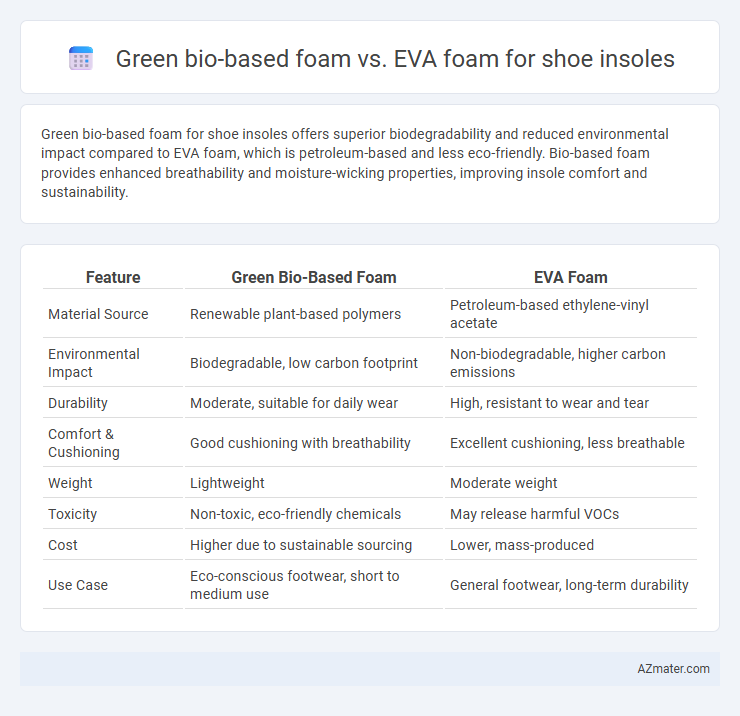Green bio-based foam for shoe insoles offers superior biodegradability and reduced environmental impact compared to EVA foam, which is petroleum-based and less eco-friendly. Bio-based foam provides enhanced breathability and moisture-wicking properties, improving insole comfort and sustainability.
Table of Comparison
| Feature | Green Bio-Based Foam | EVA Foam |
|---|---|---|
| Material Source | Renewable plant-based polymers | Petroleum-based ethylene-vinyl acetate |
| Environmental Impact | Biodegradable, low carbon footprint | Non-biodegradable, higher carbon emissions |
| Durability | Moderate, suitable for daily wear | High, resistant to wear and tear |
| Comfort & Cushioning | Good cushioning with breathability | Excellent cushioning, less breathable |
| Weight | Lightweight | Moderate weight |
| Toxicity | Non-toxic, eco-friendly chemicals | May release harmful VOCs |
| Cost | Higher due to sustainable sourcing | Lower, mass-produced |
| Use Case | Eco-conscious footwear, short to medium use | General footwear, long-term durability |
Introduction to Shoe Insole Materials
Shoe insoles commonly utilize materials like EVA foam and green bio-based foam to balance comfort, durability, and sustainability. EVA foam, a synthetic polymer, offers excellent cushioning and shock absorption, making it a popular choice in athletic and casual footwear. Green bio-based foam, derived from renewable resources such as plant oils or algae, provides an eco-friendly alternative with comparable flexibility and lightweight properties while reducing the environmental footprint of shoe production.
What is Green Bio-Based Foam?
Green bio-based foam is an eco-friendly material derived from renewable biomass sources such as plant oils, starches, and natural fibers, offering sustainable alternatives to petroleum-based foams like EVA. This type of foam provides similar cushioning and durability benefits for shoe insoles while significantly reducing carbon footprint and environmental impact. Its biodegradable properties and reduced reliance on fossil fuels make it a preferred choice for eco-conscious footwear manufacturing.
Overview of EVA Foam in Footwear
EVA foam, or ethylene-vinyl acetate, is widely used in shoe insoles due to its excellent cushioning, flexibility, and lightweight properties. It offers good shock absorption and durability, making it a preferred material for athletic and casual footwear. Despite its performance advantages, EVA foam is petroleum-based, raising environmental concerns compared to emerging green bio-based foams.
Sustainability and Environmental Impact
Green bio-based foam for shoe insoles significantly reduces carbon footprint through biodegradable and renewable raw materials, contrasting with EVA foam derived from non-renewable petroleum sources that contribute to environmental pollution. The biodegradability and compostability of bio-based foams enhance end-of-life sustainability by minimizing landfill accumulation and microplastic release. Lifecycle assessments demonstrate that bio-based foam production generates lower greenhouse gas emissions and energy consumption compared to conventional EVA foam manufacturing.
Comfort and Cushioning Performance
Green bio-based foam offers superior breathability and moisture-wicking properties compared to EVA foam, enhancing overall comfort during extended wear. Its natural cellular structure provides adaptive cushioning that responds better to foot pressure distribution, reducing fatigue. EVA foam delivers consistent shock absorption but tends to retain heat and moisture, potentially compromising comfort over long periods.
Durability and Lifespan Comparison
Green bio-based foam offers enhanced durability due to its natural polymer composition, which provides superior resistance to compression and wear compared to traditional EVA foam. EVA foam typically exhibits faster degradation under repeated stress and exposure to heat, resulting in a shorter lifespan for shoe insoles. Studies indicate that green bio-based foam insoles can last up to 30% longer, maintaining cushioning and structural integrity over extended use.
Breathability and Moisture Management
Green bio-based foam offers superior breathability compared to EVA foam, allowing more efficient air circulation within shoe insoles to reduce heat buildup and enhance foot comfort. Its natural polymer structure facilitates moisture wicking and rapid drying, effectively managing sweat and minimizing odor during prolonged wear. In contrast, EVA foam tends to trap heat and moisture, making green bio-based foam a more sustainable and functional choice for breathable, moisture-managing shoe insoles.
Manufacturing Processes and Energy Use
Green bio-based foam insoles are produced using renewable plant-based materials through bio-synthesis or fermentation, requiring lower energy inputs and emitting fewer greenhouse gases compared to EVA foam manufacturing. EVA foam involves polymerizing ethylene and vinyl acetate derived from fossil fuels, a process with higher energy consumption and significant reliance on petrochemical feedstocks. The sustainable production methods of bio-based foams contribute to reduced environmental impact, making them energy-efficient alternatives in shoe insole manufacturing.
Cost Analysis and Market Trends
Green bio-based foam for shoe insoles offers a rising alternative to traditional EVA foam due to increasing consumer demand for sustainable materials, although it currently presents higher production costs driven by raw material sourcing and limited manufacturing scale. Market trends indicate a growing adoption of bio-based foams in footwear, supported by regulatory incentives and brand commitments to environmental responsibility, which could reduce costs over time through economies of scale and technological advances. Cost analysis reveals EVA foam remains more cost-effective short-term, but the projected shift toward eco-friendly products positions green bio-based foam as a competitive option in future market segments focused on sustainability.
Future Outlook: The Next Steps for Eco-Friendly Insoles
Green bio-based foam offers significant potential for eco-friendly shoe insoles by utilizing renewable resources and reducing carbon footprints compared to traditional EVA foam, which is petroleum-based. Research and development focus on improving durability, cushioning properties, and biodegradability to meet consumer demand for sustainable footwear solutions. Future outlook highlights scaling production, enhancing material performance, and integrating circular economy principles to drive widespread adoption in the footwear industry.

Infographic: Green bio-based foam vs EVA foam for Shoe insole
 azmater.com
azmater.com